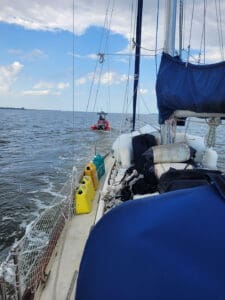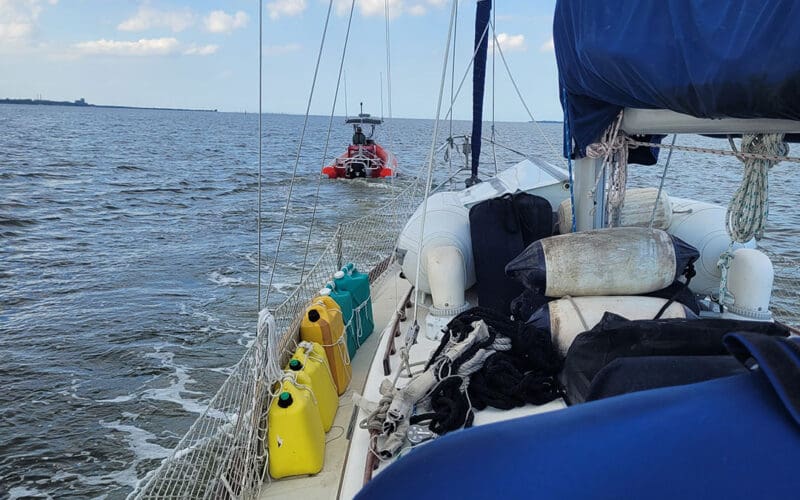
Editor’s note: This experience of two cruisers shows the importance of having spares aboard if at all possible.
We left Titusville, Florida bound for Vero Beach via the Intracoastal Waterway (ICW). There wasn’t a breath of wind, so we were motoring.
After about three hours into our expected six-hour trip, we noticed a subtle change in the sound of the engine. Janet was at the helm, so I got up to check. Before I even reached the bottom of the companionway ladder, there was a horrible shrieking and the sound of metal grinding, then the engine’s overheat alarm sounded. Janet shut down the engine and used our momentum to move the boat to the edge of the ICW channel while I ran forward to drop the anchor. This section of the Indian River is quite shallow, so the channel was a very narrow strip dredged through the flats. Not much room to maneuver. This whole scene took just a minute.
When we came to rest, there was only about eight inches of water below our keel and a faint plume of smoke rising from the engine compartment.
With the boat safely out of the channel and the anchor down, we tried to figure out what was going on. The infrared thermometer showed that the temperature of the primary alternator was at more than 220 degrees and the top of the engine block was almost as hot. Little chunks of alternator belt were strewn around the engine compartment and there was an acrid smell of burnt rubber.
We removed the belts and spun the pulleys for both alternators and the freshwater pump by hand. All but the pulley on the primary alternator rotated freely. The primary alternator was completely seized. For good measure, we also checked the raw water pump impeller, which was fine (but we changed it anyway, since we had it all taken apart).
Diagnosis-after-the-fact: the bearings on the primary alternator burnt up (for reasons that are still unknown but it was 18 years old) and this caused the belt to stop turning. The metallic grinding sound was the alternator bearings seizing and the screeching sound was the drive pulley spinning against a stationary belt (and getting chewed up). That belt also drives the pump for the freshwater (coolant) side of the heat exchanger. A stuck belt meant no coolant circulation, leading to an overheated engine. We had a dead alternator and no spare with which to replace it and no way to repair it. We didn’t really need the alternator to run the engine but without it we couldn’t tension the belt to run the water pump. So the engine was inoperable.
At this point, we knew we were in for a long day. We made lunch with an eye on the wind, which at that point was light. There was still the possibility that it could turn and push us into shallower water. Time for a plan.
We wanted to get to a dock, to make it easier to do the repair work. There were three marinas within five miles of us, all to our south. The afternoon breeze was supposed to be favorable for sailing in that direction. To help us get through the lulls and wind shadows near the bridges, we launched the dinghy and tied it alongside to act like a tug boat.
The plan was falling into place, but then we found out that none of those three marinas to our south had room for us. We now realized our best option was to go back to Titusville. Our dockage there was already paid up through the end of the week, the Titusville Marina has a DIY workshop that we could use, there is a good mechanic right next door to the marina, and there are parts suppliers within walking distance of the dock. The trouble was that Titusville was almost 20 miles north of us. Too far to rely on the dinghy for propulsion, we’d have to sail up the long, narrow ICW channel and negotiate a drawbridge that was undergoing construction (meaning that we’d have to dodge tug and barge traffic). We certainly could have sailed it. But it was going to involve a lot of tacking and because it was now about 3:30 in the afternoon, we wouldn’t get to Titusville until well after dark. And then we’d need a tow into the marina anyhow because the marina staff weren’t going to let us sail in or use our dinghy to push us into a slip. The marina is densely packed with very little room to maneuver. (We’ve since learned that “no tow-ins” is a common policy in Florida, which is probably why the first three marinas said they didn’t have room for us.)
So one of us (the smart one) suggested we call TowBOAT US and get a tow all the way to Titusville. We have been paying BOAT US for boat insurance and towing insurance for decades, and have never made a claim of any kind. In the interest of getting things sorted out as quickly as possible, we swallowed our pride and called the “Red Boat of Shame.” We hoisted the dinghy back aboard and 45 minutes later, were under tow and hurtling north at a dizzying 6.5 knots.
The towboat captain was very professional and got us to Titusville with plenty of daylight to spare. It’s not easy to maneuver a boat under tow into a slip. But he made it look easy. The marina staff were ready to take our lines and assist. Our friends Ann Beardsley and Elliot Walsh had drinks waiting for us. Plus they fed us a good, hot dinner. (Janet remarked: no fooling, I cried a little at that point. It was so kind.) And Elliott was a huge help on the following day, during the battle to remove the old alternator.
Not knowing how long it would take to get a new alternator or to rebuild the old unit, we ordered a new one from Beta Marine and also took the old one to “The Guy Over At Titusville NAPA.” His name is Kelly and he used to own an automotive electrical shop. He now works at NAPA and does starter and alternator repair jobs on the side from his house. Everyone told us that having Kelly fix it would be the fastest, cheapest, and best solution. And they were right. Kelly completely refurbished the alternator that evening and had it ready for us by 8:00 AM the next day.
We re-installed the alternator, gave the engine a little extra TLC, crossed our fingers and turned the key. The mighty beast came right back to life without a hitch. n
Damon and Janet Gannon have worked on the water from the Gulf of Mexico to the Bay of Fundy. They are currently enjoying a year’s “pretirement,” sailing their Pacific Seacraft 37, Fulmar, up and down the Intracoastal Waterway.

